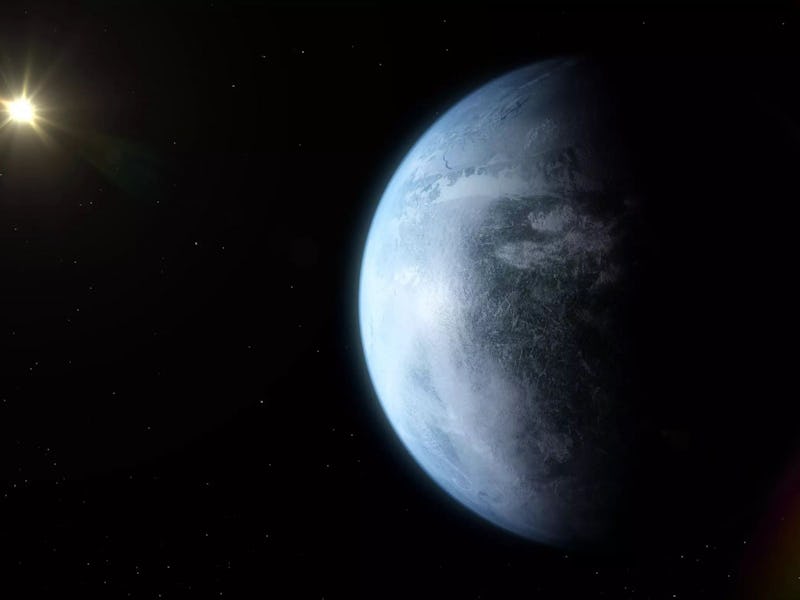Scientists Have Glimpsed 59 New Exoplanets in Our Backyard
They include 43 “Earths and Super-Earths.”

The hunt for habitable extrasolar planets continues! Thanks to dedicated missions like Kepler, TESS, and Hubble, the number of confirmed extrasolar planets has exploded in the past fifteen years (with 5,272 confirmed and counting!).
At the same time, next-generation telescopes, spectrometers, and advanced imaging techniques now allow astronomers to study exoplanet atmospheres more closely. In short, the field is shifting from the process of discovery to characterization, allowing astronomers to more tightly constraint habitability.
Finding potentially-habitable “Earth-like” planets around these fainter stars is the purpose of the Calar Alto high-Resolution search for M dwarfs with Exoearths with Near-infrared and optical Echelle Spectrographs (CARMENES), located at the Calar Alto Observatory in Spain.
Sophisticated planet-hunting
In a study that appeared in Astronomy & Astrophysics today, the CARMENES Consortium published data (Data Release 1) data from about 20,000 observations taken between 2016 and 2020. Among the measurements obtained from 362 nearby cool stars, the DR1 contained data on 59 new planets.
The CARMENES instrument is an optical and near-infrared spectrograph mounted on the 3.5-meter telescope and one of the most sophisticated planet-hunting in the world using the Radial Velocity Method.
Also known as Doppler Spectroscopy, this method consists of measuring light from distant stars with spectrometers to look for signs of redshift and blueshift — which show if the planet is moving back and forth. This movement indicates the presence of gravitational forces acting on the star (i.e., a system of orbiting planets) and can yield accurate mass estimates.
The CARMENES Consortium that designed and built this instrument includes more than 200 scientists and engineers from 11 Spanish and German institutions.
As of 2015, the Consortium’s purpose has been to look for terrestrial-type exoplanets around nearby red dwarf stars. Since then, the CARMENES instrument has doubled the number of known exoplanets around nearby M-type stars using the Radial Velocity Method.
The 59 exoplanets they identified between 2016 and 2019 are either new discoveries or confirmations of previously-detected candidates, including 6 Jupiter-like gas giants, 10 Neptune-like gas giants, and 43 Earths and Super-Earths. A dozen of these latter planets were found to orbit within the stars’ circumsolar habitable zones.
“Since it came into operation, CARMENES has re-analyzed 17 known planets and has discovered and confirmed 59 new planets around stars in the vicinity of our Solar System, making a significant contribution to expanding the census of nearby exoplanets,” said Ignasi Ribas, a researcher at the ICE-CSIC and Director of the Institute of Space Studies of Catalonia (IEEC) who led the study, in a recent MPIA press release.
“In order to determine the existence of planets around a star, we observe it a minimum of 50 times,” added Juan Carlos Morales, an IEEC researcher at ICE-CSIC. “Although the first round of data has already been published to grant access to the scientific community, the observations are still ongoing.”
Artist’s conception of a rocky Earth-mass exoplanet like Wolf 1069 b orbiting a red dwarf star.
Stimulating data
The paper published in Astronomy & Astrophysics is the 100th study produced by the CARMENES Consortium, demonstrating the project’s success in detecting exoplanets around fainter, low-mass stars. Between 2016 and 2019, CARMENES observed almost half of all nearby M-type stars in two near-infrared wavelength ranges — 0.52 to 0.96 µm and 0.96 to 1.71 µm — some of which can only be observed from the Southern Hemisphere.
In addition, the spectra they obtained provided information about the atmospheres of the stars and their planets, which is essential to characterization.
The Consortium team hopes that the publication of this first large dataset will stimulate further research and discoveries. Experts are also using the visible light data from the stars surveyed to improve CARMENE’s infrared data processing.
Once that information becomes public, astronomers will have another large dataset of observations to work with. In the meantime, the Consortium is conducting more observations of the same stars through CARMENES Legacy-Plus, which began in 2021 and is expected to last until the end of 2023.
The CARMENES Consortium plans to survey about 300 late-type main-sequence stars M5V stars — red dwarf suns roughly 0.162 times as massive as the Sun. The ultimate goal is to detect up to 2 million Earth-like planets that orbit within the habitable zones of M-type stars. This will go a long toward settling the debate about whether or not life can survive under “crimson skies,” which remains the subject of considerable debate.
This article was originally published on Universe Today by Matt Williams. Read the original article here.
This article was originally published on